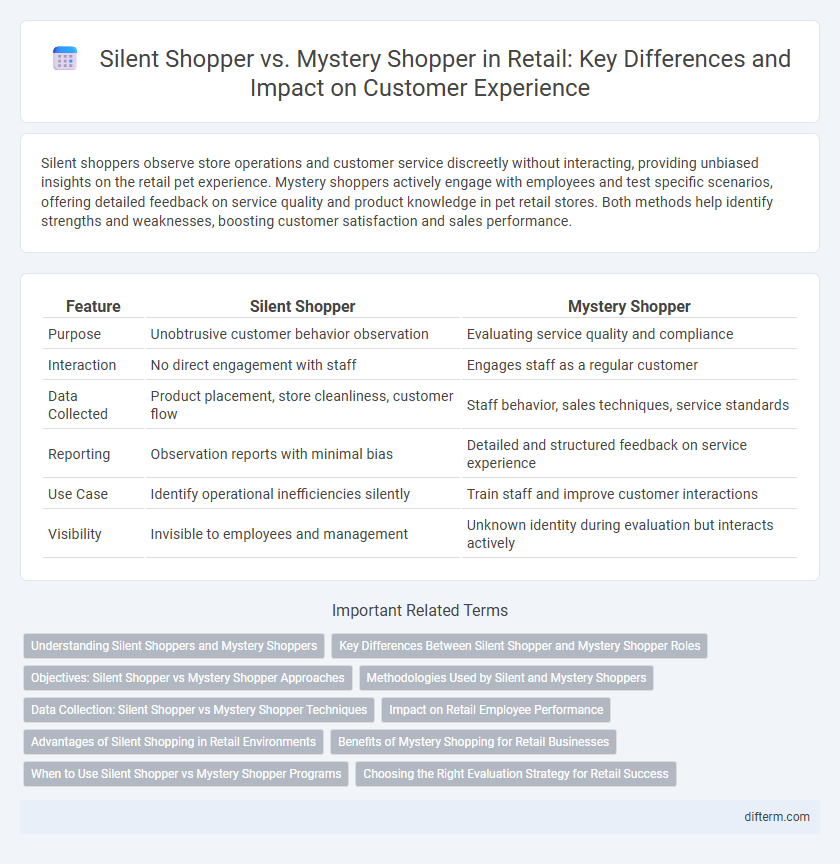Silent shoppers observe store operations and customer service discreetly without interacting, providing unbiased insights on the retail pet experience. Mystery shoppers actively engage with employees and test specific scenarios, offering detailed feedback on service quality and product knowledge in pet retail stores. Both methods help identify strengths and weaknesses, boosting customer satisfaction and sales performance.
Table of Comparison
| Feature | Silent Shopper | Mystery Shopper |
|---|---|---|
| Purpose | Unobtrusive customer behavior observation | Evaluating service quality and compliance |
| Interaction | No direct engagement with staff | Engages staff as a regular customer |
| Data Collected | Product placement, store cleanliness, customer flow | Staff behavior, sales techniques, service standards |
| Reporting | Observation reports with minimal bias | Detailed and structured feedback on service experience |
| Use Case | Identify operational inefficiencies silently | Train staff and improve customer interactions |
| Visibility | Invisible to employees and management | Unknown identity during evaluation but interacts actively |
Understanding Silent Shoppers and Mystery Shoppers
Silent shoppers are customers who privately evaluate retail service quality without informing staff, providing unbiased insights on employee behavior and store environment. Mystery shoppers are hired evaluators who follow specific scenarios to assess customer service, product availability, and compliance with company standards in retail settings. Both methods offer valuable data for improving store operations, but mystery shoppers deliver structured feedback while silent shoppers reveal genuine everyday customer experiences.
Key Differences Between Silent Shopper and Mystery Shopper Roles
Silent Shopper primarily observes customer service and store conditions without interacting with employees, while Mystery Shopper engages directly with staff to evaluate their behavior and service quality. Silent Shoppers gather unbiased data on store environment, product availability, and cleanliness, whereas Mystery Shoppers assess specific employee performance metrics through scripted interactions. Both methods provide valuable retail insights, but Mystery Shopping delivers detailed feedback on interpersonal skills and transaction processes, contrasting with the observational focus of Silent Shopping.
Objectives: Silent Shopper vs Mystery Shopper Approaches
Silent Shopper aims to observe customer experiences and employee behavior without interference, providing unbiased insights on store atmosphere and service quality. Mystery Shopper conducts structured evaluations through predefined scenarios to assess compliance with company standards and identify training gaps. Both approaches optimize customer satisfaction but target different aspects: Silent Shopper focuses on natural interaction, while Mystery Shopper emphasizes performance measurement.
Methodologies Used by Silent and Mystery Shoppers
Silent shoppers utilize unobtrusive observation techniques, monitoring customer interactions and store environment without direct engagement to gather authentic behavioral data. Mystery shoppers employ simulated purchasing scenarios and staff interactions, providing detailed qualitative feedback on service quality, compliance, and product presentation. Both methodologies rely on structured evaluation criteria but differ in their interaction levels, with silent shoppers emphasizing natural observation and mystery shoppers focusing on experiential assessment.
Data Collection: Silent Shopper vs Mystery Shopper Techniques
Silent shoppers rely on unobtrusive observation and behavioral tracking tools to collect authentic customer experience data without influencing shopper behavior. Mystery shoppers use pre-defined scenarios and direct interaction techniques, providing qualitative feedback through structured surveys and detailed reports. Effective data collection combines silent shopper technology-driven insights with mystery shopper subjective evaluations for comprehensive retail performance analysis.
Impact on Retail Employee Performance
Silent shoppers observe retail employees without interaction, allowing unbiased assessment of genuine customer service behaviors and identifying improvement areas in real-time performance. Mystery shoppers engage with employees, simulating typical customer interactions to evaluate service quality, product knowledge, and adherence to company protocols. Combining both methods enhances retail employee performance by providing comprehensive feedback on both actual behavior and service execution under evaluation conditions.
Advantages of Silent Shopping in Retail Environments
Silent shopping offers unique advantages by enabling retailers to observe genuine customer behaviors without influencing their actions, resulting in more accurate insights into shopping patterns and preferences. This method reduces the risk of altered employee behavior, providing an authentic evaluation of service quality and store atmosphere. Leveraging silent shoppers helps retailers identify real-time operational improvements and optimize customer experience strategies effectively.
Benefits of Mystery Shopping for Retail Businesses
Mystery shopping provides retail businesses with valuable insights into customer service quality, employee performance, and store cleanliness, enabling targeted improvements that enhance the overall shopping experience. Unlike silent shoppers who may only observe, mystery shoppers actively engage with staff and evaluate real-time interactions, uncovering hidden issues and training needs. This method helps retailers increase customer satisfaction, boost sales, and maintain consistent brand standards.
When to Use Silent Shopper vs Mystery Shopper Programs
Silent shopper programs are ideal for ongoing, day-to-day evaluation of customer service and store conditions without alerting employees, providing real-time insights into typical customer experiences. Mystery shopper programs are best suited for specific campaigns or targeted assessments, where detailed reports and evaluations of predefined scenarios help identify gaps in training or compliance. Retailers use silent shoppers for continuous improvement and mystery shoppers for audit-type evaluations or promotional effectiveness.
Choosing the Right Evaluation Strategy for Retail Success
Choosing the right evaluation strategy in retail depends on the specific goals and depth of insights required; silent shoppers gather unbiased data through discreet observation, ideal for assessing natural customer service dynamics. Mystery shoppers engage more interactively, providing detailed feedback on employee behavior, product knowledge, and store environment, which helps identify training needs and operational gaps. Balancing silent and mystery shopper programs enhances comprehensive evaluation, driving improvements in customer experience and retail success.
Silent Shopper vs Mystery Shopper Infographic

 difterm.com
difterm.com